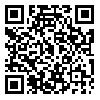Volume 20, Issue 3 (March 2020)
Modares Mechanical Engineering 2020, 20(3): 637-647 |
Back to browse issues page
Download citation:
BibTeX | RIS | EndNote | Medlars | ProCite | Reference Manager | RefWorks
Send citation to:



BibTeX | RIS | EndNote | Medlars | ProCite | Reference Manager | RefWorks
Send citation to:
Zamani J, Hosseinzadeh R. Experimental Investigation of the Effect of Change in Geometric Parameters of Shock Tube on the Intensity of Shock Wave. Modares Mechanical Engineering 2020; 20 (3) :637-647
URL: http://mme.modares.ac.ir/article-15-21454-en.html
URL: http://mme.modares.ac.ir/article-15-21454-en.html
1- Mechanical Engineering Faculty, K. N. Toosi University of Technology, Tehran, Iran , ex.forminglab@kntu.ac.ir
2- Mechanical Engineering Faculty, K. N. Toosi University of Technology, Tehran, Iran
2- Mechanical Engineering Faculty, K. N. Toosi University of Technology, Tehran, Iran
Abstract: (4316 Views)
Determining the behavior of structures under high-speed loading at different applications is very important. One of the most important equipment in this field is a shock tube that can simulate the mentioned objects above in a laboratory environment. The aim of this paper is to investigate the effect of the geometrical parameters of the shock tube on the impulse of the shock wave generated. In this study, the effect of change in outlet diameter with the nozzle and the variation in the length of the driver and driven sections on the wave created in the decrease and increase shock intensity has been investigated. In this regard, the functional components of the 3-inch gas-driven shock tube were investigated on the dynamic deformation of aluminum sheets. Based on the results, the length of the driver is not effective on the peak of the generated wave pressure. However, the driven length effects on the deformation of the sheet, in this way that the shorter the driven length is, the higher the dome height will be. The effect of concentrating the shock wave on the sheet is visible in the samples in which the nozzle is embedded. This demonstrates that a more centralized dynamic load has led to deform the sheet. Also, at high pressures compared with lower pressures, the nozzle effect is better in concentrating the shock wave from the explosion in the shock tube.
Article Type: Original Research |
Subject:
Impact Mechanics
Received: 2018/05/28 | Accepted: 2019/06/12 | Published: 2020/03/1
Received: 2018/05/28 | Accepted: 2019/06/12 | Published: 2020/03/1
References
1. Duff RE, Blackwell AN. Explosive driven shock tubes. Review of Scientific Instruments. 1966;37(5):579-586. [Link] [DOI:10.1063/1.1720256]
2. Davis WC, Salyer TR, Jackson SI, Aslam TD. Explosive-driven shock waves in argon. The 13th International Detonation Symposium, 2006 July 23-28, Norfolk, Virginia. Arlington: Office of Naval Research; 2006. pp. 1035-1044. [Link]
3. Courtney AC, Andrusiv LP, Courtney MW. Oxy-acetylene driven laboratory scale shock tubes for studying blast wave effects. Review of Scientific Instruments. 2012;83(4):045111. [Link] [DOI:10.1063/1.3702803]
4. Stotz I, Lamanna G, Hettrich H, Weigand B, Steelant J. Design of a double diaphragm shock tube for fluid disintegration studies. Review of Scientific Instruments. 2008;79(12):125106. [Link] [DOI:10.1063/1.3058609]
5. Colombo M, Di Prisco M, Martinelli P. A new shock tube facility for tunnel safety. Experimental Mechanics. 2011;51(7):1143-1154. [Link] [DOI:10.1007/s11340-010-9430-7]
6. Furukawa T, Aochi T, Sasoh A. Expansion tube operation with thin secondary diaphragm. AIAA Journal. 2007;45(1):214-217. [Link] [DOI:10.2514/1.23846]
7. Glass II, Patterson GN. A theoretical and experimental study of shock-tube flows. Journal of the Aeronautical Sciences. 1955;22(2):73-100. [Link] [DOI:10.2514/8.3282]
8. Hsu UK. Numerical and experimental investigation of a supersonic flow field around solid fuel on an inclined flat plate. Modelling and Simulation in Engineering. 2009;2009:4. [Link] [DOI:10.1155/2009/823874]
9. Mediavilla Varas J, Philippens M, Meijer SR, Van Den Berg AC, Sibma PC, Van Bree JL, et al. Physics of IED blast shock tube simulations for mTBI research. Frontiers in Neurology. 2011;2:58. [Link] [DOI:10.3389/fneur.2011.00058]
10. Kosing OE, Skews BW. An investigation of high-speed forming of circular plates in a liquid shock tube. International Journal of Impact Engineering. 1998;21(9):801-816. [Link] [DOI:10.1016/S0734-743X(98)00033-5]
11. Gardner KD, John AG, Lu FK. Development of a shock loading simulation facility. Shock. 2005;1000(2):3. [Link]
12. Pankow M, Waas AM, Bednarcyk B. Blast loading of epoxy panels using a shock tube [Report]. Washington, D.C: NASA; 2010 Dec. Report NO: NASA/TM-2010-216941, E-17545. Contract NO.: WBS 698259.02.07.03. [Link]
13. Justusson B, Pankow M, Heinrich C, Rudolph M, Waas AM. Use of a shock tube to determine the bi-axial yield of an aluminum alloy under high rates. International Journal of Impact Engineering. 2013;58:55-65. [Link] [DOI:10.1016/j.ijimpeng.2013.01.012]
14. Courtney E, Courtney A, Courtney M. Shock tube design for high intensity blast waves for laboratory testing of armor and combat materiel. Defence Technology. 2014;10(2):245-250. [Link] [DOI:10.1016/j.dt.2014.04.003]
15. Andreotti R, Colombo M, Guardone A, Martinelli P, Riganti G, Di Prisco M. Performance of a shock tube facility for impact response of structures. International Journal of Non-Linear Mechanics. 2015;72:53-66. [Link] [DOI:10.1016/j.ijnonlinmec.2015.02.010]
16. Anderson Jr JD. Fundamentals of aerodynamics. New York: McGraw-Hill; 2003. p. 912. [Link]
17. Smith PD, Hetherington JG. Blast and ballistic loading of structures. Oxford: Butterworth-Heinemann; 1994. [Link]
18. Sorensen HK. ABAQUS theory manual. Version 6.2 [Software]. 2001 [Unknown cited]. Available from: Not Found [Link]
19. Beusink M. Measurements and simulations on the (dynamic) properties of aluminium alloy AA6060 [Dissertation]. Eindhoven: Eindhoven University of Technology; 2011. [Link]
Send email to the article author
| Rights and permissions | |
 |
This work is licensed under a Creative Commons Attribution-NonCommercial 4.0 International License. |







